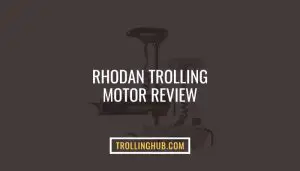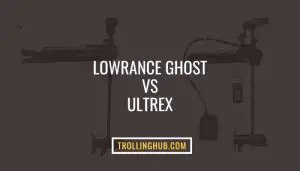The most amazing fact about the lake trout is their togetherness. If you can catch one trout, you can catch more trout in this area at the same time because the lake trout like schooling in the same place. They don’t like to be scattered. And this is where trolling for lake trout comes in extremely handy.
To help you troll for lake trout effortlessly, we’ve prepared this article based on the 7 best trolling techniques. Studying these strategies will help you know what temperature, speed, timing, depth, lure types, rigs, and many more factors that work best for lake trout. So, let’s begin!
Are Lake Trout Hard To Catch?
Catching lake trout isn’t hard. But it can be challenging for beginners sometimes. It can be difficult if you go at the wrong time or use the wrong trolling techniques. Otherwise, catching lake trout isn’t anything challenging.
Because lake trouts are members of the char family. These species like living in pollution-free and clean water bodies. They also like to be in cold water. It’s the most common species which you’ll get available on every water surface.
What Is The Best Way To Catch Lake Trout?
Trolling is undoubtedly the best way to catch lake trout. However, you must learn the proper trolling tricks.
When you think about trolling for lake trout, downriggers can be the best classic settings. In the next section of our article, we’ll explain all the details. Keep going through!
There are several factors to keep in mind, for example, trolling rigs, proper speeds, timing, etc. You have to focus on all these factors considering where and how you’re trolling.
What Do You Use To Troll For Lake Trout?
There is a list of fishing gear that we need while trolling for lake trout. Here are some of the must-have examples-
When you troll for lake trout, you must purchase an action rod with a lightweight design. Okuma Celilo trout trolling rod can be your best fishing partner. Not only do you need an action rod, but you also need to purchase a 3-way swivel.
To attract lake trout and catch more of them, the fishing spoons work the best. Spoons like Akuna will be a good choice for lake trout.
Trolling For Lake Trout: 7 Best Techniques
The following tips will help you know how to troll for lake trout trouble-free-
1. Shoreline Structure
Before you go trolling, take a close look at the shoreline structure. Lake trout prefer drop-offs. So, we recommend you troll parallel. However, don’t go over the string of shoals. The lake trout sit underneath and wait silently for injured or weak fish to make their deed.
2. Wind Type
For trout fishing, the wind is a very important factor. Usually, the tout availability is more on the lakesides where the wind blows tremendously.
3. Trolling Motor Size
To troll for lake trout, you need not get a high speed. Moving the boat slowly is perfect to catch this species. In this case, we suggest not using a bigger trolling motor as they are hard to control when you need to slow the speed. Small size trolling motor is perfect for lake trout fishing.
4. Weather
The cooler weather climates are favorable for lake trout. When the water temperature starts increasing, they tend to go deeper into the lake water column. If the weather is full of cold wind, you need not go too deep or far for the lake trout.
5. Natural Bait Types
If you want to use natural baits, go for different types of earthworms. Nightcrawls, mealworms, salmon eggs, grasshoppers, crayfish, leeches, minnows, etc are excellent choices for lake trout. These natural baits are easily found and are also very successful sources for lake trout fishing.
6. Temperature
The most comfortable water warmth is from 34°F to 65°F. Most of the time of the day, lake trout stay in the water temperature that ranges generally from 40° to 50°F. They can also be found in the 59°F of water temperature.
However, the temperature varies from time to time which affects the trout’s feeding capacity. Therefore, considering the water temperature every hour is important while trolling for lake trout.
7. Place Where Trouts are Found
In the deep freshwater large lakes, for example, Great Lakes is the most common place for lake trout. Lake trout are native to the following popular places as well-
- St. Mary Lake
- Waterton Lake
- Cosley Lake
- Glenns Lake, etc.
How Deep Should You Troll For Lake Trout?
When it’s time to find out where the trout are available it’s time to know how deep do lake trout live. In most cases, the trout inhabitants are more than 50 feet deep but it’s not a fixed measurement. Trout is a mysterious species that can be found at 50 feet depth and again at 200 feet depth too.
Count how many times the fishing line gets out when you drop it to the bottom of the lake. It will help you get an ideal estimate of the depth level where the trouts are available. For lake trout, the ideal depth ranges between 30 and 60 feet. Here’s a great tip to get the best depth to catch them-
- In the Winter- The depth level should be 10 feet
- In the Mid-Spring- It varies between 35 and 45 feet
- In the Late-Spring- It ranges between 50 and 65 feet
- In the Summer- It stays straight at the same depth of late spring at 50 and 65 feet
Special Trick: It will be a nice idea to use a depth finder to map the school of trout.
What Is The Best Trolling Speed For Lake Trout?
The moderate trolling speed which means fast but not faster is the ideal speed level. Ensure your boat isn’t moving at high speed. It will make your trolling challenging.
The targeting trolling speed for your lake trout should be 2mph. However, the lake trout trolling speed isn’t a fixed measurement. Notice how speedily the species follow your lure. And, based on that condition, slow down or speed up.
What Lb Test Line Should I Use For Trout?
Usually, the test line ranges between 2 to 6 lbs for lake trout fishing. However, in the case of the large lake trout, the lighter monofilament test line ranging from 6 to 10 lbs is considered the best. This weight of the line will result in better trout fishing through the lure movement.
Trolling For Lake Trout With Downriggers
A downrigger is the most useful option for trolling for lake trout. It can assist you to place your lure in the required depth of over 60 feet which is tough to reach with other trolling methods. It can target the appropriate depth level focusing the trout on the lake water column.
Downrigger is the best trolling method for lake trout in the summertime. Since lake trout are cold water species, they begin to go deep and deep over 100 feet to thrive in the summer heating time, especially in July and August.
At that time downrigger is considered the best possible trolling method to reach that depth. However, you must be careful while trolling for trout with downriggers.
- Lift the boom inboard to set the line. Ensure the boom isn’t swinging up and not grabbing the wire cable. This practice will secure your trolling from falling overboard.
- When lowering the boom, lower it slowly. Dropping it down steadily can damage the boom in terms of its heavy weight. And before you put the downrigger on the boat floor, make sure the floor is free of fuel containers, tackle boxes, and other clutter.
It’s necessary to keep the place free especially when you’re in a small craft. Because things can be tangled up and also fall off. First-time users of downriggers should remember the given factors below-
- Lift the rod and release the line from the clip
- Ensure the trout won’t wrap the stainless steel cable when you raise the cannonball
- In terms of an electric downrigger, you need to press the switch only to raise the cannonball
- Ensure a constant follow-up on the fishing lines
All these things, to begin with, might seem difficult in the first phase. However, after a couple of downrigger operations, you’ll be used to this practice.
Safety Tip: Start trolling with the downrigger slowly. You shouldn’t be in a rush while operating the downrigger.
Trolling For Lake Trout Without Downriggers
Although the downrigger is the best way to reach the depth, you still can troll for lake trout up to 60 feet depth without a downrigger. Many anglers think it impossible to fish lake trout without downriggers and they become frustrated.
However, fishing lake trout without a downrigger is also possible in many ways. The two popular methods are the flat-line and core-line fishing methods. You can use any one of them. Here’s the detail-
1. Flat-Line Fishing Method
In this method, you can fish along the shoreline. You have to let the fishing line out behind your trolling boat. Using planner boards, you can use several flat lines at the same time to cover the large water surface. As a result, you can catch more fish.
- Speed for Flat-Line Fishing
The ideal flat-line trolling tips come with a speed that ranges from 1.3 mph to 3+ mph. First, you need to begin with a slower speed between 1.5 and 1.8 mph. If you find no lake trout are responding, increase the speed.
- Current Type for Flat-Fishing </ul>
- Weather Types for Flat-Fishing
- 3-Way Rig
- Spin-N-Glo Rig
- Cowbell Rig
- Dodger Rig
- Tie the main line with a 3-way swivel
- Ensure the mainline weights are between 20 and 30 lbs
- Now tie the dropper line with the other swivel eye
- Add a weight of up to 8oz with the dropper line
- Now tie a leader from 2 to 3 feet (15 to 20 lbs) with the 3rd eye of the swivel and also tie a snap swivel. Ensure you tied it at the end of the swivel eye and you can attach it to the lure for lake trout
Trolling with and into the current isn’t the same thing while going through flat-fishing. Trolling into the strong current requires you to focus on the trolling lures. And, increase/decrease the speed based on the fish response. However, trolling with a stable current is pretty easy and you can go with the usual speed level.
In the springtime when the water remains cold, lake trout come up on the water’s surface almost close to the land to find their food. The flat-line fishing can be very productive in that situation. It’s the best time to present your lure through the flat-line method and it works in an outstanding way.
2. Core Line
The core-line method can also be the best way to troll for lake trout while not using a downrigger. It’s designed to sink faster into the lake water. The core line will also allow you to reach the maximum depth as same as the flat line.
Tip: Use a fish finder to determine the exact depth where the lake trout are available. Once you find the depth, set your core line and start trolling without the downrigger.
Trolling For Lake Trout With Dipsy Divers
The Dipsy Divers is one of the advanced trolling sinkers available in the present vintage. You’ll be able to lead to multi-directional trolling with the round shape of Dipsy Divers. Also, it will offer an instant change in your diving system in terms of its two different diver sizes.
As same as the other diving planners, the Dipsy Divers also held in its planning considering its lead weight. This weight can be molded into an adjustable base plate. And, productivity comes right here. You can rotate that base plate left and right according to your necessity. It will lead the diver to move to either the starboard side or to the port side as per the tout’s presence.
Wire Line Trolling For Lake Trout
Whether wireline or braided line trolling is good depends on how you troll. Many anglers believe that wire line trolling isn’t for all, especially for novice anglers. Because the wireline can kink and stretch and also get rust in it.
It often challenges the anglers no matter whether they use standard or solid wire materials such as stainless, monel, or copper.
However, all these happen if you’re not an expert on dealing with wire line trolling. Once you’re comfortable with it, you can troll deeper.
Trolling Cowbells For Lake Trout
Choosing the cowbell trolling rig can be the best to target lake trolling. It’s the classical attractor setup that works great for lake trout as well as salmon.
Trolling on big lakes necessitates an exceptional and effective trolling method like the cowbells. The cowbell rig can rotate trouble-free around the metal wire because of its spinner blades. The spinner blades are designed to be attached to the cowbell clevis.
The cowbell trolling method is the most popular trolling method for lake trolling in terms of its unique blade design. In this case, it works incredibly when you choose it for lake trout. It produces a productive fish-calling vibration which provides maximum flash.
Applying this trolling method will enable you to draw lake trout from a greater distance and also create more strikes. It offers flexible cable rigging, a variety of blade sizes, trolling rudder, and trolling length. You’ll be able to maximize your success through cowbells.
How Do You Rig For Trolling Lake Trout?
There are 4 different rigs set up available for trolling lake trout. And these are-
However, the 3-way rig setup is the most popular and helpful method It’s the best setup for springtime lake trout trolling. Because the lake trout are found in shallow water at that time. Here’s how you go for this-
NB: Spring and Autumn are the best time for a 3-way rig setup
Best Time To Troll For Lake Trout
You can catch the lake trout more or less throughout the day based on the trolling seasons. Still, there’s a crucial question what is the best time of day to fish for lake trout? From dawn to the early morning is the best time of the day to troll for lake trout.
Because the water temperature remains cold at that time no matter whether it’s the hot summertime, also, the later evening is considered the ideal time.
And if you focus on the summer and spring, the best time for trolling for lake trout in spring
is the late morning. When the summer comes near, the late afternoon seems the best time.
On the other hand, the morning up to 11 am is considered the best time for trolling for lake trout in summer.
Best Lake Trout Trolling Lures
You’ll get many high-performed trolling lures available on the market for lake trout. Here are the two top-used lures-
1. Trout Magnet Fishing Lure


This Magnet fishing lure is one of the best lures for trout. It’s designed for trout as well as many other species. The slim and long design allows this lure to offer a perfect stop-and-go action. Besides, this lure can rattle on its move to enhance its effectiveness.
2. Wicked Lures for Trout


Wicked lures are designed especially for freshwater lake trout. This lure will be available in 2 different colors black, and blue. So, you can choose your required one. It comes with a brass sheet and octopus hook to deliver great action.
FAQs
Monofilament is the best bet for trolling for lake trout. In this case, the size can be from 30 to 40 lbs.
Since the lake trout like living in the deeper water column, silver, blue, chartreuse, pink, and orange are all the best colors. These colors’ lures will be clearly visible at any depth level.
</div>The live baits are the best things to attract lake trout the most. You also can use human food, such as Velveeta cheese and marshmallows.
Hook size from 8 inches to 14 inches works the best.
Since lake trout like to be in cooler water surfaces, generally they like deep water rather than shallow water. Because the shallow water surface begins to heat up in the noon.
</div>When the water temperature goes up to 65°F, the possibility to get trout is the least. Try avoiding fishing the lake trout at this high temperature.
Final Thoughts
Anglers think trolling for lake trout is complicated. However, lake trout species are the most common and easily found species. You’ll find it available in almost all types of water bodies. And, if you are thinking of trolling for lake trout, there’s nothing to be worried about.
If you follow the right place at the right time and select all the proper fishing gear, catching lake trout will be easier and also enjoyable.
<!-- CONTENT END 2 -->


